
The English garden is a very old idea that started in the 18th century.
It was designed to be a beautiful and peaceful place. By using soft colors and lots of flowers, you can create a wonderful outdoor space.
Imagine walking on winding paths, sitting in cozy areas, and having a special garden room.
This can be a great place to relax and be creative. Let’s look at 17 ideas to make your outdoor space a beautiful and fun place to be.
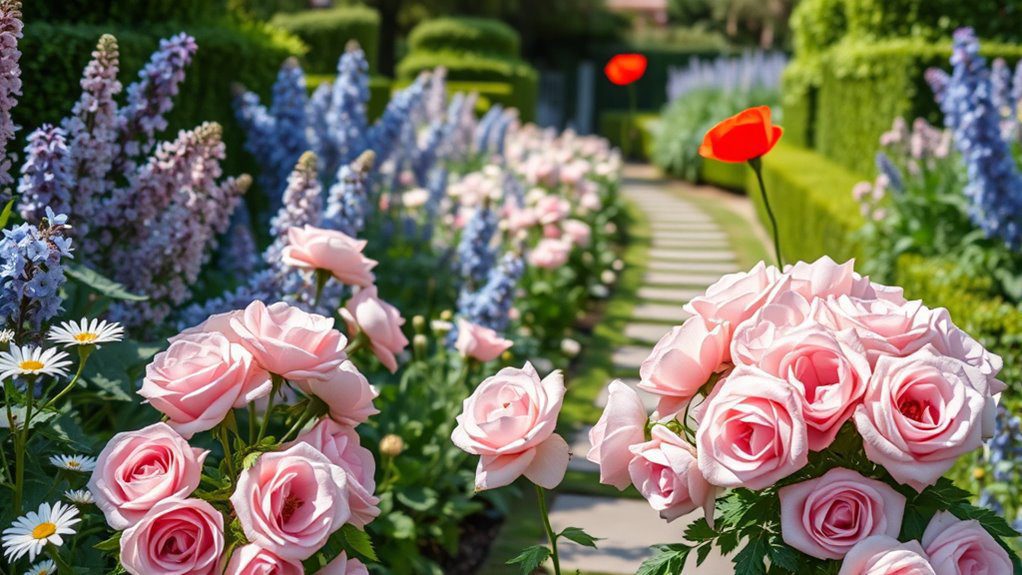
Choosing a classic color palette for your English garden can create a timeless and harmonious atmosphere. Opt for traditional colors such as soft pastels, deep hues, and a mix of whites and creams. Soft pinks, lilacs, and blues can blend beautifully with lush greenery, while bold reds or purples can provide striking focal points. Incorporating plants with varying bloom times guarantees a constant show of color throughout the seasons, enhancing the garden’s elegance and charm.
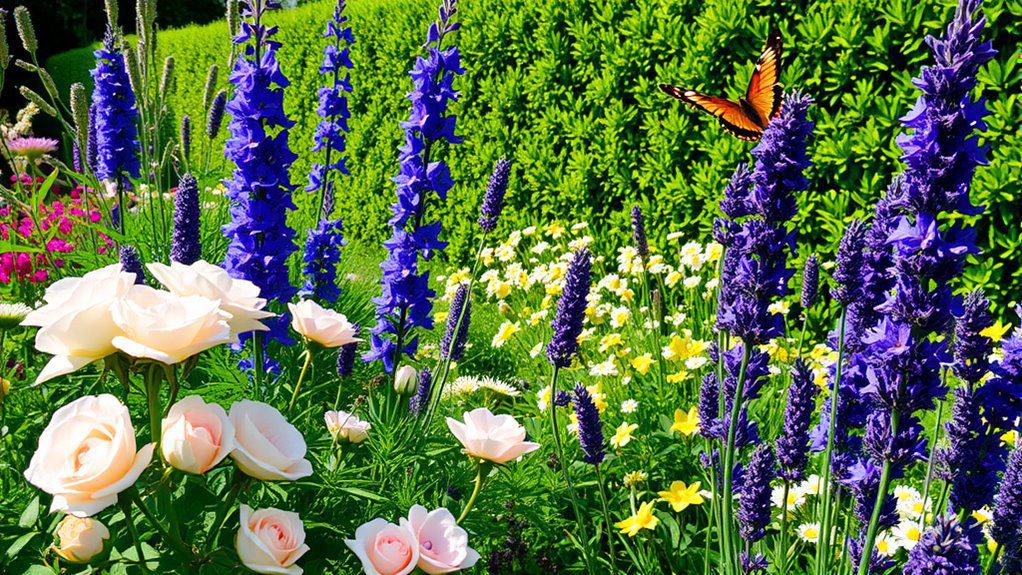
Incorporating a variety of flowering plants into your English garden not only enhances its aesthetic appeal but also promotes biodiversity. Select a mix of perennials, annuals, and bulbous plants to guarantee continuous blooms throughout the seasons. Popular choices include roses, delphiniums, and lavender, which provide vibrant colors and delightful fragrances. This diversity attracts pollinators like bees and butterflies, creating a lively ecosystem while offering a stunning visual display for garden enthusiasts.
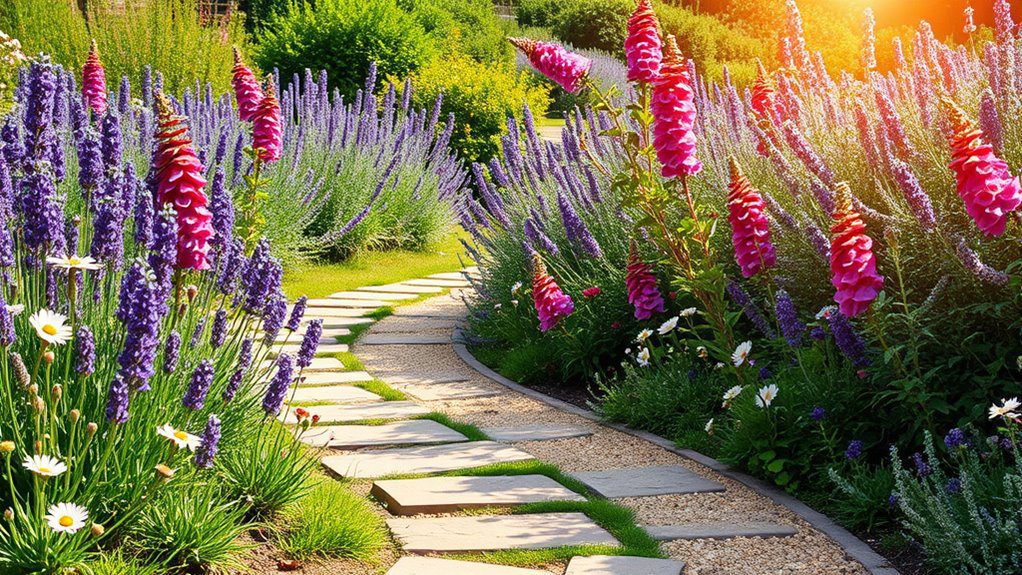
Designing a meandering pathway in your English garden adds charm and movement to the landscape. Use natural stone, gravel, or bricks to create a winding trail that invites exploration. Surround the pathway with lush perennials, aromatic herbs, and flowering shrubs to enhance the sensory experience. Incorporate gentle curves to soften the look and create visual interest. This pathway not only guides visitors through the garden but also encourages them to linger and appreciate the beauty of each turn.
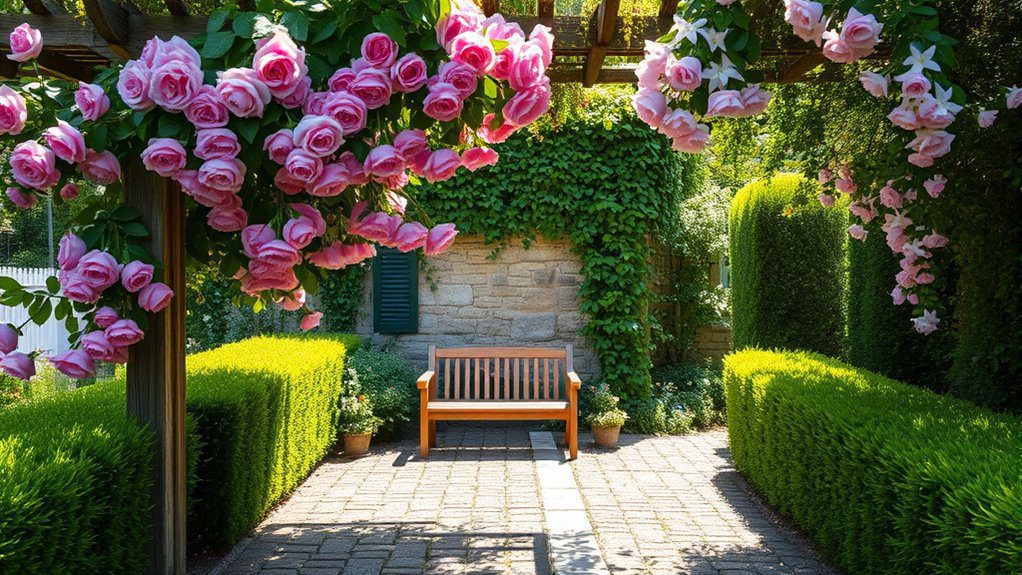
Adding a charming trellis to your English garden not only enhances its aesthetic appeal but also serves practical purposes. A trellis can support climbing plants like roses, wisteria, or clematis, creating a lush vertical display that adds depth to your garden. You can position it against a wall, fence, or as a standalone feature, draping it in blooms to provide privacy or define garden spaces. For an authentic English garden feel, consider using rustic wood or wrought iron designs that blend seamlessly with the natural surroundings.
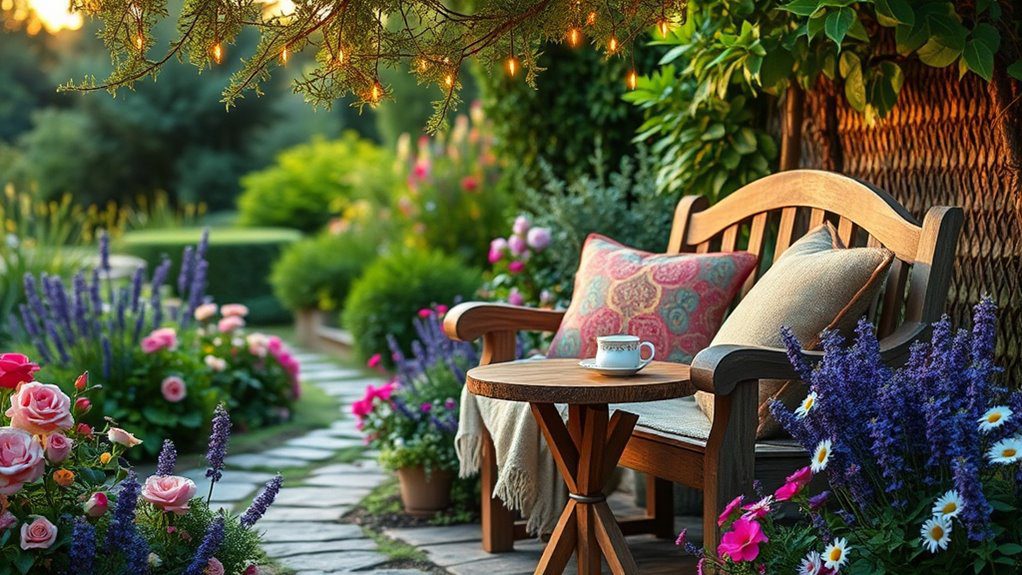
A cozy seating area in your English garden can serve as a tranquil escape and a social hub for gatherings. Consider installing comfortable chairs or a charming bench surrounded by lush greenery and floral beauty. Add soft cushions and warm throws for a touch of comfort, and incorporate a small table for drinks or snacks. Lighting, such as fairy lights or lanterns, can enhance the ambiance, making it an inviting spot to unwind or entertain under the stars.
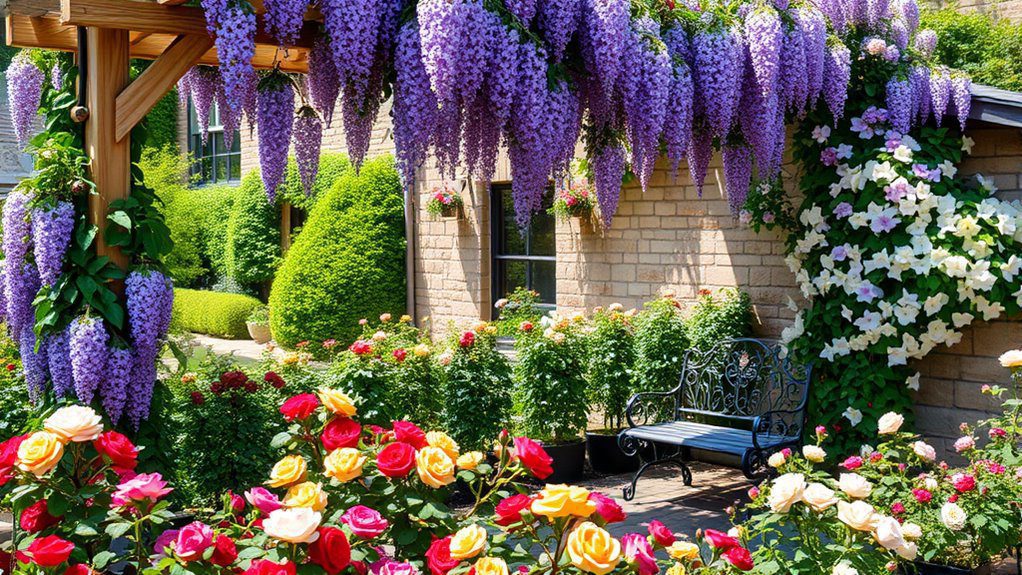
Climbing plants are an excellent choice for enhancing the beauty and vertical appeal of your English garden. They create a lush tapestry by growing up trellises, walls, and arbor structures, adding layers of color and texture. Popular options include roses, wisteria, and clematis, which can transform bland spaces into vibrant focal points. Additionally, climbing plants provide natural privacy barriers and can help shade outdoor areas, making them a functional and aesthetic addition to any garden design.
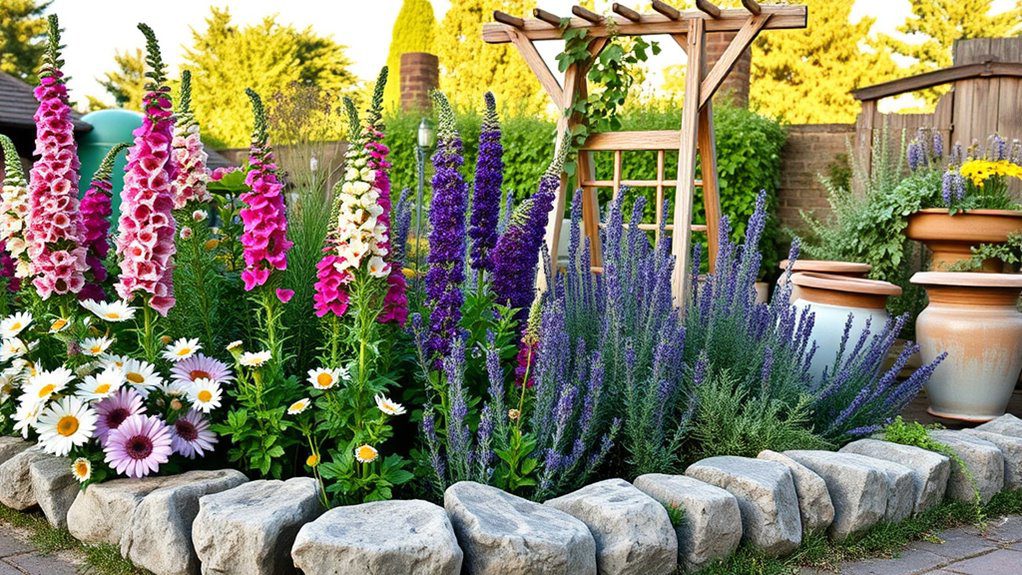
Creating a cottage-style border in your garden adds a charming and whimsical touch. To achieve this, combine a mix of perennial flowers, such as foxgloves, daisies, and lavender, with low-growing plants like creeping thyme or ground covers. Use natural materials like weathered stone or reclaimed wood to form an informal edge, allowing plants to spill over slightly. Incorporate rustic garden accessories, such as handmade trellises or vintage pots, to enhance the cozy, inviting atmosphere of your cottage-style border.
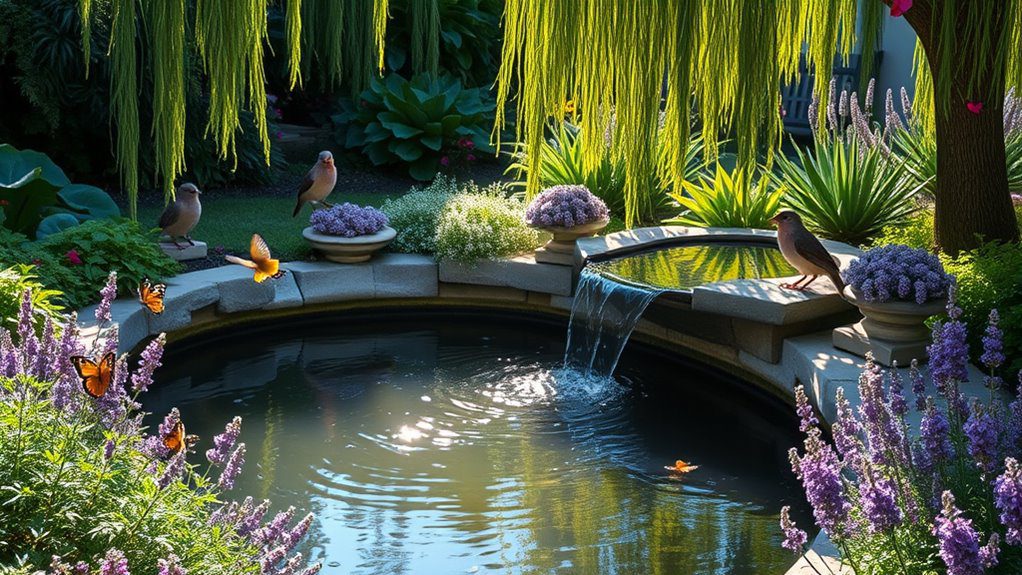
Implementing a water feature in your English garden can enhance its tranquility and visual appeal. Consider adding a small pond, a bubbling fountain, or a trickling waterfall to create a soothing ambiance. These elements attract wildlife, such as birds and butterflies, and serve as a focal point in your landscaping. Surround the water feature with lush plants like ferns and lavender to blend it seamlessly into the garden, promoting relaxation and a natural ecosystem.
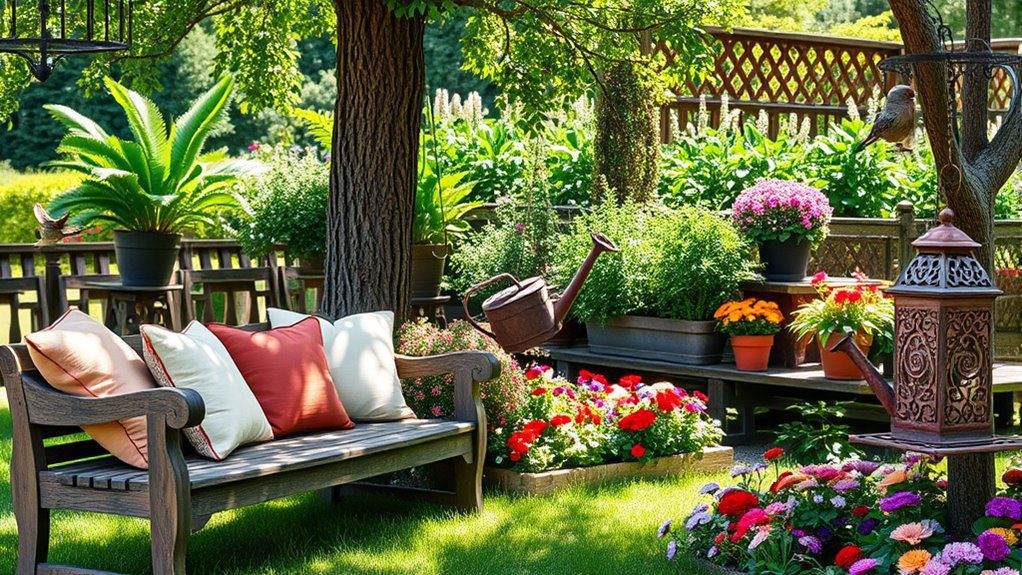
Choosing antique or rustic garden accessories can add charm and character to your outdoor space. Items like vintage watering cans, weathered wooden benches, and ornate bird feeders not only serve functional purposes but also evoke a sense of nostalgia and timeless beauty. Incorporating these pieces alongside lush greenery and colorful blooms creates a harmonious blend of elegance and nature, making your garden a delightful retreat. Search for unique finds at local flea markets or online antique shops to personalize your garden’s aesthetic.
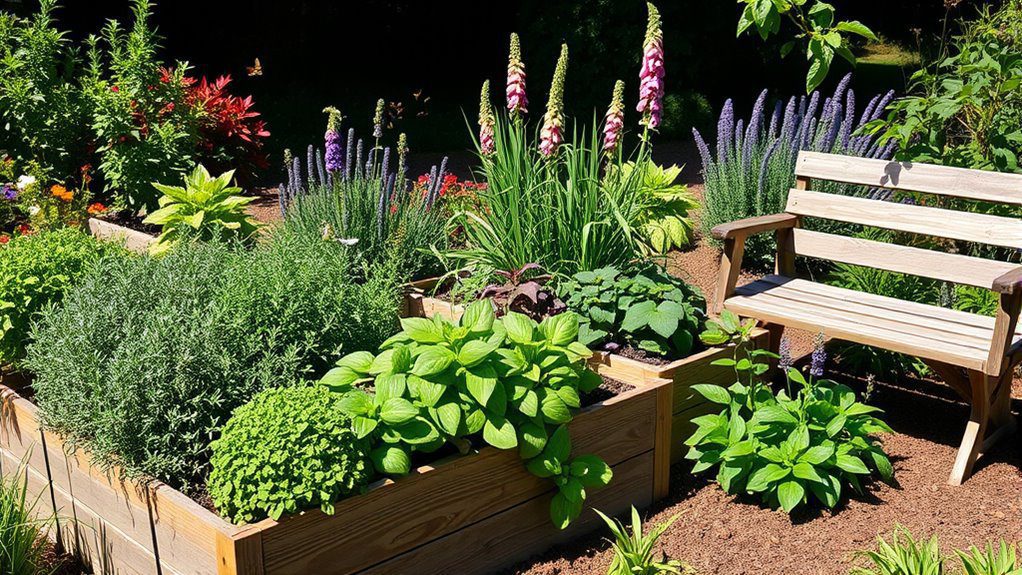
Incorporating herb garden sections into your English garden can enhance both aesthetics and functionality. Choose a sunny spot to create raised beds or containers filled with fragrant herbs such as rosemary, thyme, and basil. These plants not only provide delightful scents and colors but also attract beneficial pollinators. Mixing herbs with traditional flowers can create a lush, cottage-like feel, while also supplying fresh ingredients for your kitchen, making your garden both beautiful and practical.
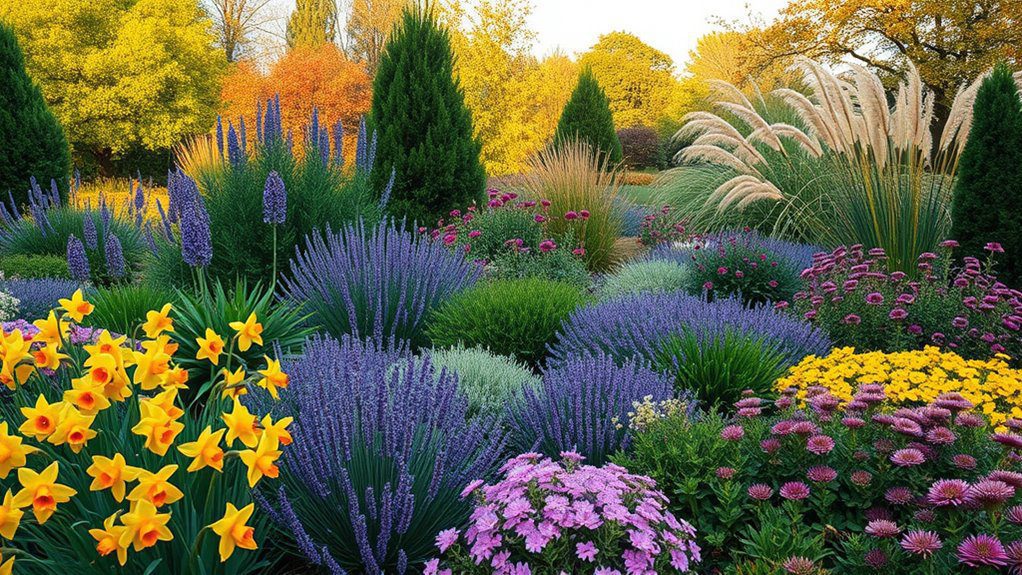
To create a garden with year-round interest, select a diverse array of plants that bloom across different seasons. Incorporate evergreens for structure and greenery during the winter, alongside spring-flowering bulbs like daffodils and tulips. Shift into summer with vibrant flowering perennials such as echinacea and lavender, and finish with autumn staples like ornamental grasses and asters. Mixing textures, colors, and seasonal features guarantees your garden remains visually appealing throughout the year.
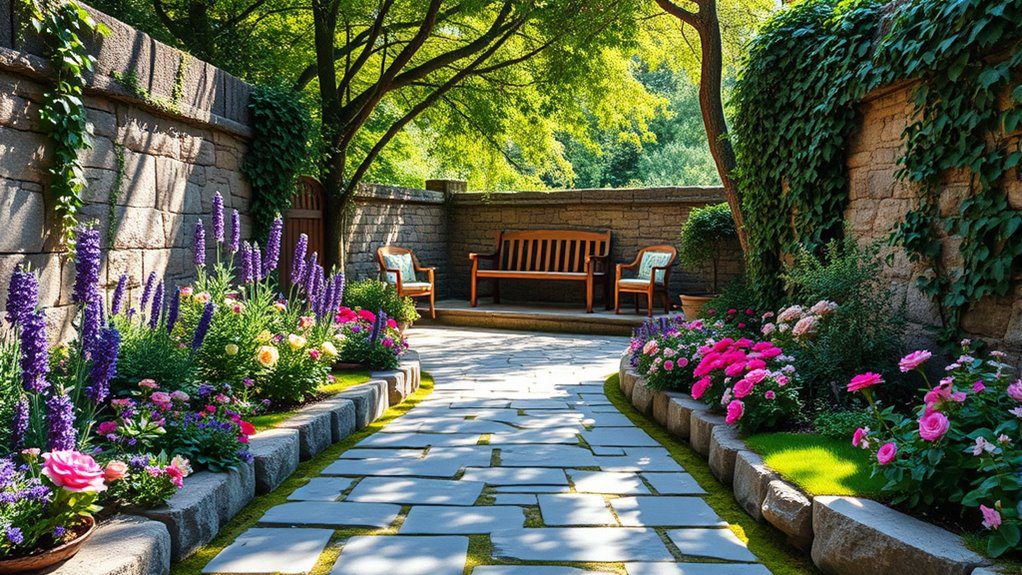
Using natural stone for hardscaping in your English garden not only enhances its beauty but also creates a timeless, rustic charm. Stones like slate, limestone, and granite can be used for walkways, patios, and walls, blending seamlessly with the landscape. Their durability guarantees longevity, while the variety of textures and colors can complement various plantings. Incorporating natural stone elements fosters a connection with nature, making your garden a serene retreat.
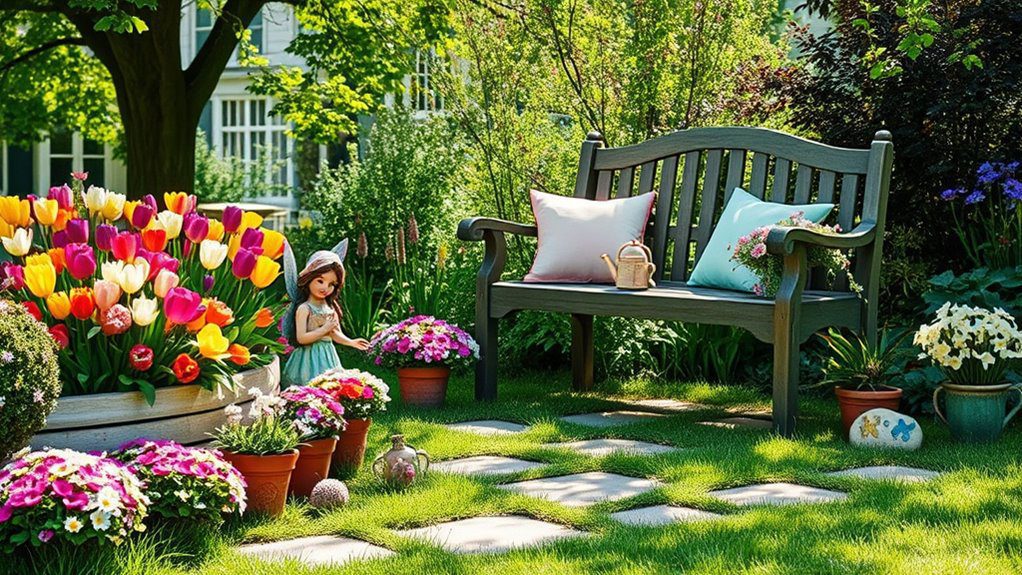
Enhancing your English garden with seasonal decorations adds a vibrant touch and showcases the changing times of the year. In spring, consider colorful flower pots and whimsical garden ornaments to celebrate new blooms. Summer invites cheerful bunting or lanterns for evening gatherings. Autumn can be adorned with pumpkins and dried foliage, while winter invites twinkling lights and evergreen arrangements. These seasonal accents not only beautify the space but also reflect the charm and joys of each season, making your garden inviting year-round.
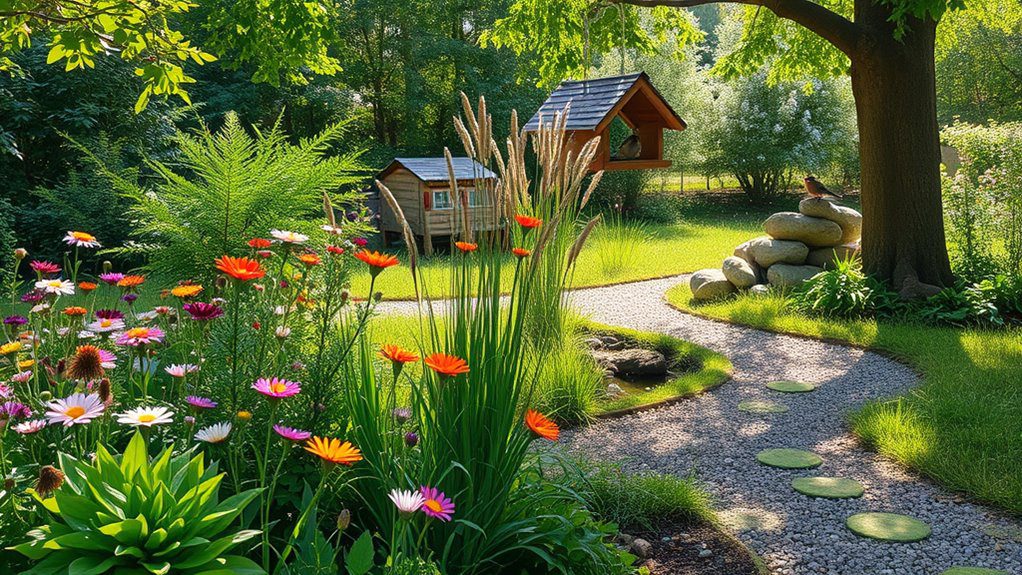
Creating a wildlife-friendly space in your English garden can foster biodiversity and enhance its natural beauty. Start by incorporating native plants that provide food and habitat for local birds, insects, and small mammals. Adding features like a small pond, bird feeders, and strategically placed logs or rock piles can encourage wildlife visits. Avoid pesticides and opt for organic gardening methods to guarantee a safe environment. This harmonious approach not only delights wildlife but also enriches your gardening experience.
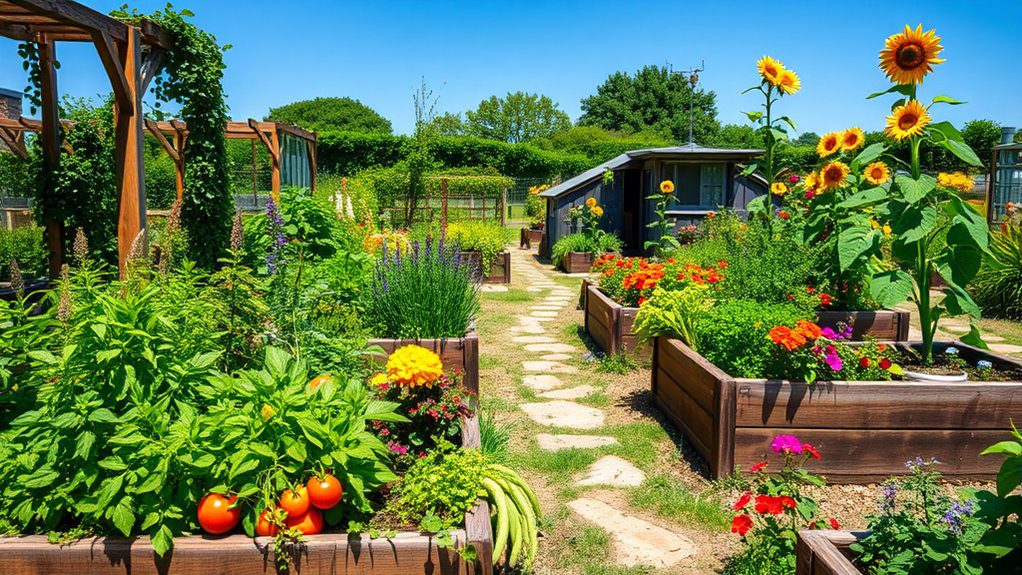
Incorporating a kitchen garden into your English garden design not only enhances the aesthetic appeal but also provides fresh herbs, vegetables, and fruits right at your doorstep. Designate a sunny spot and use raised beds, containers, or traditional plots to cultivate your favorite edibles. Surround the garden with flowers, such as marigolds or nasturtiums, to attract pollinators and add vibrant color. This eco-friendly addition encourages sustainability and promotes a healthy lifestyle while enjoying the beauty of nature.
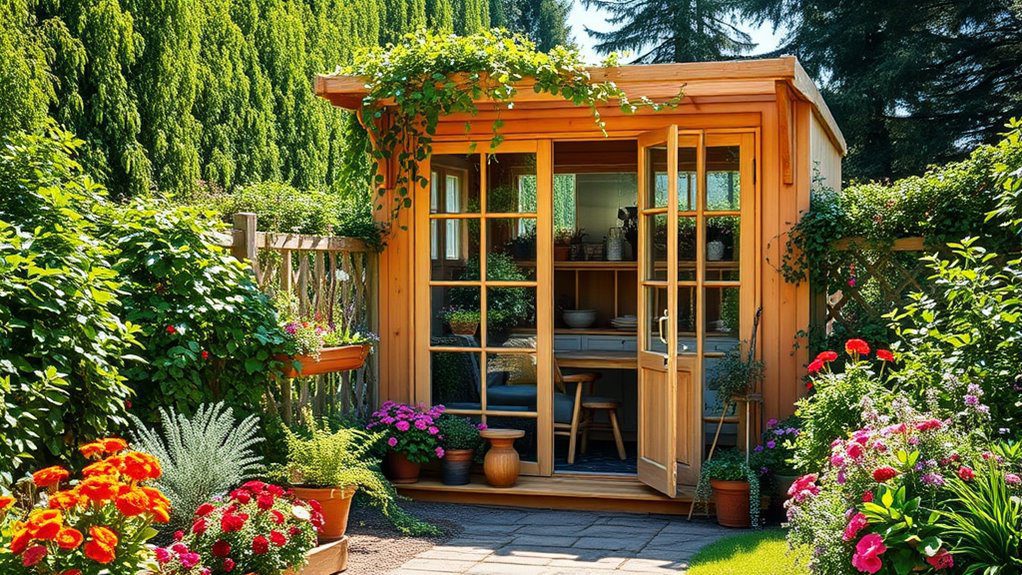
Creating a garden room or shed can be a beautiful addition to your English garden, providing a serene space for relaxation, creativity, or storage. Choose a design that harmonizes with your garden’s landscape, using natural materials like wood or stone. Include large windows to bring in natural light and integrate greenery with climbing plants or window boxes. This space can be a perfect retreat for gardening enthusiasts, artists, or simply a cozy spot to enjoy the outdoors year-round.
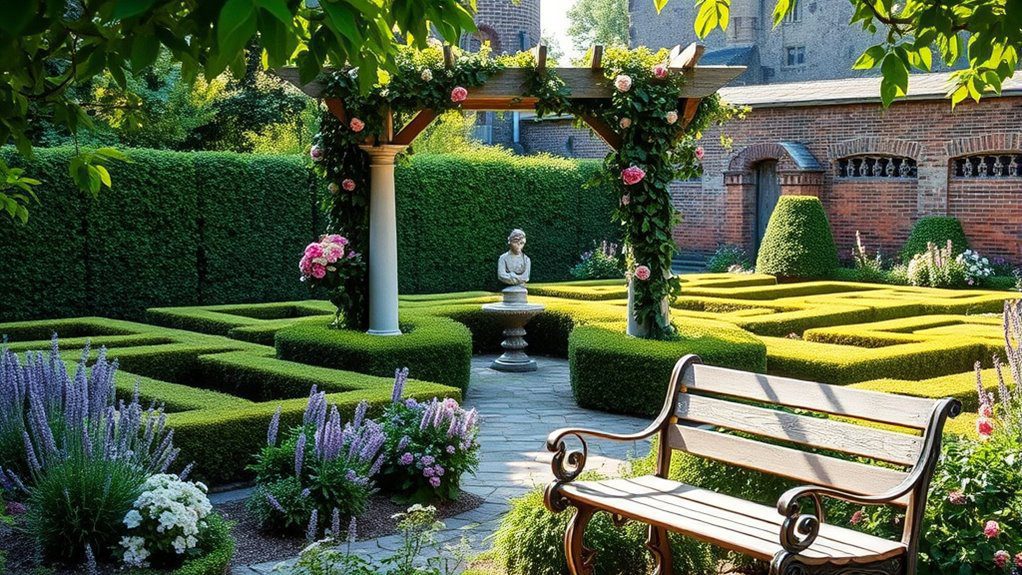
Embracing English garden architecture involves incorporating classic design elements that highlight harmony and symmetry in outdoor spaces. Key features include structured hedges, charming pathways, and focal points such as pergolas or statues. Incorporating materials like brick or stone complements the natural beauty of flora, while elements like trellises promote climbing plants. The result is a picturesque, inviting landscape that reflects the elegance and timelessness characteristic of traditional English gardens, creating a serene retreat for relaxation and enjoyment.
In the end, transforming your outdoor space into an English garden masterpiece isn’t just about pretty blooms and meandering paths; it’s a full-time job that demands your devotion—like raising a pet! If you’re ready to cultivate beauty, embrace the chaos of nature’s whims and the occasional rogue squirrel. So grab your trowel and let the allure of elegance sweep you off your feet. After all, who wouldn’t want to spend weekends pretending they live in a Jane Austen novel?

Don't let aphids, slugs, and caterpillars ruin another plant. Take back control with simple, natural methods that actually work.